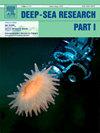Mesoscale ocean eddies determine dispersal and connectivity of corals at the RMS Titanic wreck site
IF 2.3
3区 地球科学
Q2 OCEANOGRAPHY
Deep-Sea Research Part I-Oceanographic Research Papers
Pub Date : 2024-10-03
DOI:10.1016/j.dsr.2024.104404
引用次数: 0
Abstract
The sinking of the RMS Titanic on 15 April 1912 remains one of most iconic maritime disasters in history. Today, the wreck site lies in waters 3800 m deep approximately 690 km south southeast of Newfoundland, Atlantic Canada. The wreck and debris field have been colonized by many marine organisms including the octocoral Chrysogorgia agassizii. Because of the rapid deterioration of the Titanic and the vulnerability of natural deep-sea coral populations to environmental changes, it is vital to understand the role the Titanic as well as other such structures could play in connecting ecosystems along the North American slope. Based on Lagrangian experiments with more than one million virtual particles and different scenarios for larval behavior, given the uncertainties around the biology of chrysogorgiids, the dispersal of larvae spawned at the Titanic wreck is studied in a high-resolution numerical ocean model. While the large-scale bathymetry shields the Titanic from a strong mean flow, mesoscale ocean eddies can considerably affect the deep circulation and cause a significant speed up, or also a reversal, of the circulation. As a consequence, the position of upper and mid-ocean eddies in the model largely controls the direction and distance of larval dispersal, with the impact of eddies outweighing the importance of active larval swimming in our experiments. Although dependent on larval buoyancy and longevity, we find that the Titanic could be reached by larvae spawned on the upper slope east of the Grand Banks. Therefore, the Titanic could act as a stepping stone connecting the upper to the deep continental slope off Newfoundland. From the Titanic, larvae then spread into deep Canadian waters and areas beyond national jurisdiction.
中尺度海洋漩涡决定了泰坦尼克号沉船遗址珊瑚的扩散和连通性
1912 年 4 月 15 日沉没的泰坦尼克号皇家邮轮仍然是历史上最具标志性的海难之一。如今,沉船地点位于加拿大大西洋纽芬兰东南约 690 公里处 3800 米深的水域。沉船和残骸区已被包括章鱼 Chrysogorgia agassizii 在内的许多海洋生物所占据。由于泰坦尼克号的迅速损坏以及天然深海珊瑚种群对环境变化的脆弱性,了解泰坦尼克号以及其他类似结构在连接北美斜坡生态系统方面可能发挥的作用至关重要。考虑到金眼鲷生物学的不确定性,研究人员在拉格朗日实验的基础上,利用 100 多万个虚拟粒子和不同的幼虫行为方案,在高分辨率数值海洋模型中研究了泰坦尼克号沉船上产卵的幼虫的扩散情况。虽然大尺度的水深为泰坦尼克号挡住了强大的平均流,但中尺度的海洋漩涡会对深层环流产生很大影响,导致环流明显加速或逆转。因此,模型中上层和中层海洋漩涡的位置在很大程度上控制着幼虫的扩散方向和距离,在我们的实验中,漩涡的影响超过了幼虫主动游动的重要性。虽然取决于幼虫的浮力和寿命,但我们发现在大浅滩以东上坡产卵的幼虫可以到达泰坦尼克号。因此,泰坦尼克号可以作为连接纽芬兰沿海上坡和深大陆坡的踏脚石。然后,幼虫从泰坦尼克号扩散到加拿大深海和国家管辖范围以外的地区。
本文章由计算机程序翻译,如有差异,请以英文原文为准。
求助全文
约1分钟内获得全文
求助全文
来源期刊
CiteScore
4.60
自引率
4.20%
发文量
144
审稿时长
18.3 weeks
期刊介绍:
Deep-Sea Research Part I: Oceanographic Research Papers is devoted to the publication of the results of original scientific research, including theoretical work of evident oceanographic applicability; and the solution of instrumental or methodological problems with evidence of successful use. The journal is distinguished by its interdisciplinary nature and its breadth, covering the geological, physical, chemical and biological aspects of the ocean and its boundaries with the sea floor and the atmosphere. In addition to regular "Research Papers" and "Instruments and Methods" papers, briefer communications may be published as "Notes". Supplemental matter, such as extensive data tables or graphs and multimedia content, may be published as electronic appendices.

 求助内容:
求助内容: 应助结果提醒方式:
应助结果提醒方式:


